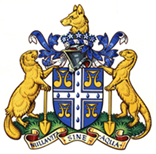
The Company of Water Conservators was pleased to host about 40 Consorts Mudlarking on the banks of the Thames in the City of London just below the Millenium Bridge. A previous event in July 2023 organised by the then Consort, Georgina Drummond, was so popular that Eileen , the Master’s Consort realised she should really run a similar event this year as Consort. Following tentative feelers in February, the enthusiastic responses resulted in the need to book two leaders from the Thames Explorer Trust to cope with the numbers.
So on Monday 10 June the Mudlarking day dawned, disappointingly chilly and damp. At least the rain had stopped before our event began. Everyone assembled on the Thames Path, at the bottom of the steps down from the Millennium Bridge, dressed appropriately. (“At last – a Livery event where I can wear wellies!”) We were accompanied by the Master, Martin, and by Sharon, the Consort of the Thames Warden, who has begun to get to know some of her future fellow Consorts.
Our guides were Marilyn and Elowyn, who spoke to us about two thousand years of London history, and the human activity along the River Thames generating countless objects intentionally discarded or accidentally dropped in its waters. For millennia, the Thames has been an extraordinary repository of these lost objects, protected and preserved in the dense, anaerobic mud.
For eleven continuous miles in London, both sides of the river were packed with docks, wharfs, warehouses, shipbuilding yards, ship-breaking yards, fish markets, factories, breweries, slaughterhouses, municipal buildings, offices, pubs and houses. The vibrant riverfront was home to thriving communities of watermen, lightermen, stevedores, dockworkers, sailors, merchants, fishermen, fishmongers, oyster wives, shipbuilders, ship-breakers and local mudlarks.

While the tide was going out, in preparation for what we might find, Marilyn and Elowyn showed us various artefacts they had picked up over the years – pieces of tobacco pipes, oyster shells (who knew oysters were once the food of the masses!?), mediaeval floor tiles, roof tiles, fragments of pottery from Georgian, Edwardian or Victoria eras, for example stoneware bellarmine jugs imprinted with the face of a bearded man on the neck (originally referred to as bartmann jugs, from the German for bearded man, but named more popularly and ironically after a cardinal who disapproved of the alcoholic contents of these bottles!).

Once advised on health and safety, we cautiously descended the famous Trig Lane steps to the foreshore. There was a little mud, some shingle, but for the most part the ground bore a strong resemblance to builders’ rubble, with relatively modern well-worn and well-washed bricks. There were animal bones and teeth a-plenty. The sharp-eyed soon spotted fragments of the various types of wares we had been told about – green glazed tiles, salt-glazed stoneware, “bakewell tart” decoration, feathering, willow pattern …

And plenty of pieces of pipe stems and fragments of the bowls. Roof tiles, with holes for pegs – round (before the Great Fire) or square (after the Great Fire). Myriads of oyster shells, one with holes showing where a piece for a mother-of-pearl button had been punched. Pieces of plates, bowls, cups, bottles …

Eventually everyone pooled thier treasures and the knowledgeable guides helped us identify the finds.
This was a fascinating time. Alas, no one was allowed to take their booty home.

Afterwards everyone crossed the Millennium Bridge to head to the Founder’s Arms to warm up and for a lunch of sharing platters which were soon demolished (as was the wine – and extra supplies were needed!).

A most educational and enjoyable time was had by all.




Post a comment